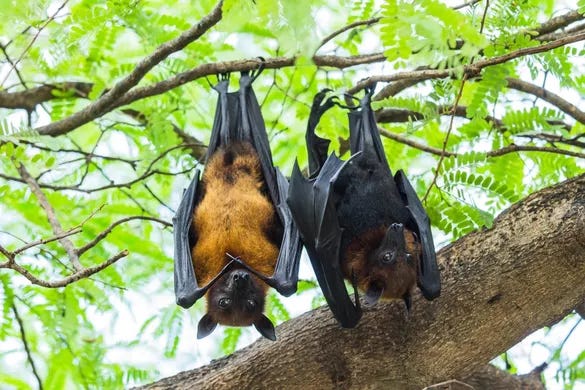In the animal kingdom, few sights are as peculiar and intriguing as that of a bat hanging upside down. This unique behavior, exhibited by bats across the globe, has piqued human curiosity for centuries. Let’s find out the reasons behind this fascinating aspect of bat life, uncovering the mysteries of these nocturnal creatures.
1. A Unique Adaptation in the Mammalian World
Bats are the only mammals capable of sustained flight, and their penchant for hanging upside down is equally singular. This behavior, known scientifically as roosting, is observed in nearly all of the 1,400 bat species. But why do these creatures choose such an unusual posture?
2. The Mechanics of Hanging Upside Down
The secret to a bat’s ability to hang upside down lies in its anatomy. Bats have a unique tendon and limb structure that allows them to lock their claws closed without expending any muscular effort. This means that a sleeping bat doesn’t have to work to hang on; instead, their body weight keeps their talons closed. This adaptation makes hanging upside down almost effortless.
3. Ease of Takeoff
Another reason bats hang upside down is related to their mode of transportation – flight. Bats cannot launch into the air from a standing position because their wings don’t generate enough lift to take off like a bird. Hanging upside down gives them the perfect position to fall into flight. Gravity aids them in getting airborne without expending much energy.
4. Safety from Predators
Hanging upside down is also a clever survival strategy. By roosting in this manner, bats can tuck themselves away in crevices, caves, and tree hollows, safe from most predators. This position makes them less visible and less accessible to animals that might pose a threat.
5. Temperature Regulation and Conservation
Some species of bats also hang upside down as a means to regulate their body temperature and conserve energy, particularly during hibernation. In cooler environments, this position allows them to reduce energy consumption and maintain body heat more effectively.
6. Social Behavior and Communication
Roosting upside down also plays a role in the social behavior of bats. Many species live in large colonies, and hanging upside down facilitates social interactions, communication, and grooming. This behavior is crucial for colony-forming species, which rely on group dynamics for survival.
7. Evolutionary Perspective
From an evolutionary standpoint, hanging upside down is a trait that has developed over millions of years. This behavior likely offered ancestral bats advantages in survival and reproduction, leading to its prevalence in the bat population today.
8. Roosting Sites: Variety and Importance
The choice of roosting sites is essential for bat survival. Bats hang upside down in a variety of environments, including caves, abandoned buildings, hollow trees, and even under bridges. Each species has specific requirements for their roosting sites, which are crucial for their mating, rearing young, and protection.
9. Human Impact on Bat Habitats
Unfortunately, human activities have significantly impacted bat habitats. Disturbance in roosting sites, habitat destruction, and pollution are some of the challenges bats face. Understanding and protecting their natural behaviors, including roosting upside down, is vital for bat conservation.
10. A Remarkable Aspect of Nature
The behavior of bats hanging upside down is a remarkable facet of the natural world. It is a testament to the incredible adaptability and diversity of wildlife. Understanding why bats hang upside down not only satisfies our curiosity but also highlights the importance of these creatures in the ecological balance. As we continue to explore the world of bats, we gain a greater appreciation for these fascinating creatures of the night and the vital roles they play in our environment.
FAQs on Why Do Bats Hang Upside Down?
- Why do bats choose to hang upside down?
- Bats hang upside down as an adaptation for survival. This position allows them to take flight easily since they cannot launch into the air like birds. Hanging upside down also provides safety from predators and aids in conserving energy, especially during rest or hibernation.
- How can bats hang upside down without falling?
- Bats have a unique tendon structure in their feet that locks their claws in a closed position when hanging. This means they can hang without using any muscular effort, essentially allowing them to stay in that position effortlessly, even while sleeping.
- Does hanging upside down have any benefits for bats?
- Yes, hanging upside down has several benefits for bats. It offers an effective way to launch into flight, provides a safe spot away from predators, facilitates temperature regulation, conserves energy, and is important for certain social interactions within colonies.
- Is it true that all bats hang upside down?
- Almost all bat species hang upside down. This behavior is observed in the majority of the 1,400 species of bats, with very few exceptions. It’s a defining characteristic of bat behavior.
- Where do bats prefer to hang upside down?
- Bats hang upside down in various places that offer safety and seclusion. Common roosting spots include caves, tree hollows, abandoned buildings, and under bridges. The choice of roosting spot depends on the species and the environmental conditions of their habitat.
- Do bats ever rest in positions other than hanging upside down?
- While the most common resting position for bats is hanging upside down, some species may occasionally rest in other positions, especially if the roosting spot allows it. However, hanging upside down is the predominant and most natural position for them.
Featured image courtesy: https://medium.com/
